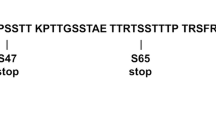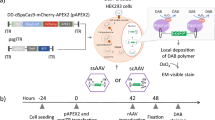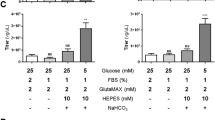Abstract
We have documented that a cellular chaperone protein, FKBP52, when phosphorylated at tyrosine and/or serine/threonine (Ser/Thr) residues, interacts with the D-sequence in the inverted terminal repeats of the adeno-associated virus 2 (AAV) genome, inhibits the viral second-strand DNA synthesis, and leads to inefficient transgene expression from recombinant AAV vectors in certain cell types. We have also demonstrated that FKBP52 is dephosphorylated at tyrosine residues by T-cell protein tyrosine phosphatase (TC-PTP), and that deliberate overexpression of TC-PTP leads to more efficient viral second-strand DNA synthesis, and increased transgene expression. However, the identity of the putative Ser/Thr protein phosphatase that dephosphorylates FKBP52 at Ser/Thr residues has remained elusive. Using known inhibitors of Ser/Thr phosphatases, we have now identified protein phosphatase 5 (PP5) to be a candidate enzyme. Deliberate overexpression of PP5 in 293 cells, which does not influence cellular growth, leads to ∼5-fold increase in the transduction efficiency of conventional single-stranded AAV vectors, but no significant enhancement in the transduction efficiency of self-complementary AAV vectors, suggesting that PP5 plays a role in AAV second-strand DNA synthesis. Electrophoretic mobility-shift assays show that in cells overexpressing PP5, the extent of the complex formation between FKBP52 and the AAV D-sequence is significantly reduced. These studies suggest that PP5-mediated dephosphorylation of FKBP52 at Ser/Thr residues augments viral second-strand DNA synthesis and enhances AAV transduction efficiency, which has implications in the optimal use of these vectors in human gene therapy.
This is a preview of subscription content, access via your institution
Access options
Subscribe to this journal
Receive 12 print issues and online access
$259.00 per year
only $21.58 per issue
Buy this article
- Purchase on Springer Link
- Instant access to full article PDF
Prices may be subject to local taxes which are calculated during checkout





Similar content being viewed by others
References
Conlon TJ, Flotte TR . Recombinant adeno-associated virus vectors for gene therapy. Expert Opin Biol Ther 2004; 4: 1093–1101.
Marshall E . Gene therapy. Viral vectors still pack surprises. Science 2001; 294: 1640.
Berns KI, Giraud C . Biology of adeno-associated virus. Curr Top Microbiol Immunol 1996; 218: 1–23.
Muzyczka N . Use of adeno-associated virus as a general transduction vector for mammalian cells. Curr Top Microbiol Immunol 1992; 158: 97–129.
Fisher KJ, Gao GP, Weitzman MD, DeMatteo R, Burda JF, Wilson JM . Transduction with recombinant adeno-associated virus for gene therapy is limited by leading-strand synthesis. J Virol 1996; 70: 520–532.
Ferrari FK, Samulski T, Shenk T, Samulski RJ . Second-strand synthesis is a rate-limiting step for efficient transduction by recombinant adeno-associated virus vectors. J Virol 1996; 70: 3227–3234.
Qing K, Hansen J, Weigel-Kelley KA, Tan M, Zhou S, Srivastava A . Adeno-associated virus type 2-mediated gene transfer: role of cellular FKBP52 protein in transgene expression. J Virol 2001; 75: 8968–8976.
Qing K, Khuntirat B, Mah C, Kube DM, Wang XS, Ponnazhagan S et al. Adeno-associated virus type 2-mediated gene transfer: correlation of tyrosine phosphorylation of the cellular single-stranded D sequence-binding protein with transgene expression in human cells in vitro and murine tissues in vivo. J Virol 1998; 72: 1593–1599.
Qing K, Li W, Zhong L, Tan M, Hansen J, Weigel-Kelley KA et al. Adeno-associated virus type 2-mediated gene transfer: role of cellular T-cell protein tyrosine phosphatase in transgene expression in established cell lines in vitro and transgenic mice in vivo. J Virol 2003; 77: 2741–2746.
Zhong L, Chen L, Li Y, Qing K, Weigel-Kelley KA, Chan RJ et al. Self-complementary adeno-associated virus 2 (AAV)-T cell protein tyrosine phosphatase vectors as helper viruses to improve transduction efficiency of conventional single-stranded AAV vectors in vitro and in vivo. Mol Ther 2004; 10: 950–957.
Zhong L, Li W, Yang Z, Chen L, Li Y, Qing K et al. Improved transduction of primary murine hepatocytes by recombinant adeno-associated virus 2 vectors in vivo. Gene Therapy 2004; 11: 1165–1169.
Zhong L, Li W, Yang Z, Qing K, Tan M, Hansen J et al. Impaired nuclear transport and uncoating limit recombinant adeno-associated virus 2 vector-mediated transduction of primary murine hematopoietic cells. Hum Gene Ther 2004; 15: 1207–1218.
Zhong L, Qing K, Si Y, Chen L, Tan M, Srivastava A . Heat-shock treatment-mediated increase in transduction by recombinant adeno-associated virus 2 vectors is independent of the cellular heat-shock protein 90. J Biol Chem 2004; 279: 12714–12723.
McCarty DM, Monahan PE, Samulski RJ . Self-complementary recombinant adeno-associated virus (scAAV) vectors promote efficient transduction independently of DNA synthesis. Gene Therapy 2001; 8: 1248–1254.
Wang Z, Ma HI, Li J, Sun L, Zhang J, Xiao X . Rapid and highly efficient transduction by double-stranded adeno-associated virus vectors in vitro and in vivo. Gene Therapy 2003; 10: 2105–2111.
Mah C, Qing K, Khuntirat B, Ponnazhagan S, Wang XS, Kube DM et al. Adeno-associated virus type 2-mediated gene transfer: role of epidermal growth factor receptor protein tyrosine kinase in transgene expression. J Virol 1998; 72: 9835–9843.
Qing K, Wang XS, Kube DM, Ponnazhagan S, Bajpai A, Srivastava A . Role of tyrosine phosphorylation of a cellular protein in adeno-associated virus 2-mediated transgene expression. Proc Natl Acad Sci USA 1997; 94: 10879–10884.
Cohen PT . Novel protein serine/threonine phosphatases: variety is the spice of life. Trends Biochem Sci 1997; 22: 245–251.
Chen MX, McPartlin AE, Brown L, Chen YH, Barker HM, Cohen PT . A novel human protein serine/threonine phosphatase, which possesses four tetratricopeptide repeat motifs and localizes to the nucleus. EMBO J 1994; 13: 4278–4290.
Becker W, Buttini M, Limonta S, Boddeke H, Joost HG . Distribution of the mRNA for protein phosphatase T in rat brain. Brain Res Mol Brain Res 1996; 36: 23–28.
Bahl R, Bradley KC, Thompson KJ, Swain RA, Rossie S, Meisel RL . Localization of protein Ser/Thr phosphatase 5 in rat brain. Brain Res Mol Brain Res 2001; 90: 101–109.
McCown TJ, Xiao X, Li J, Breese GR, Samulski RJ . Differential and persistent expression patterns of CNS gene transfer by an adeno-associated virus (AAV) vector. Brain Res 1996; 713: 99–107.
Cohen PT, Chen MX, Armstrong CG . Novel protein phosphatases that may participate in cell signaling. Adv Pharmacol 1996; 36: 67–89.
Blatch GL, Lassle M . The tetratricopeptide repeat: a structural motif mediating protein–protein interactions. Bioessays 1999; 21: 932–939.
Lu B, Ma CH, Brazas R, Jin H . The major phosphorylation sites of the respiratory syncytial virus phosphoprotein are dispensable for virus replication in vitro. J Virol 2002; 76: 10776–10784.
Chinkers M . Protein phosphatase 5 in signal transduction. Trends Endocrinol Metab 2001; 12: 28–32.
Liu F, Grundke-Iqbal I, Iqbal K, Gong CX . Contributions of protein phosphatases PP1, PP2A, PP2B and PP5 to the regulation of tau phosphorylation. Eur J Neurosci 2005; 22: 1942–1950.
Kutuzov MA, Andreeva AV, Voyno-Yasenetskaya TA . Regulation of apoptosis signal-regulating kinase 1 (ASK1) by polyamine levels via protein phosphatase 5. J Biol Chem 2005; 280: 25388–25395.
Liu F, Iqbal K, Grundke-Iqbal I, Rossie S, Gong CX . Dephosphorylation of tau by protein phosphatase 5: impairment in Alzheimer's disease. J Biol Chem 2005; 280: 1790–1796.
Gong CX, Liu F, Wu G, Rossie S, Wegiel J, Li L et al. Dephosphorylation of microtubule-associated protein tau by protein phosphatase 5. J Neurochem 2004; 88: 298–310.
Wechsler T, Chen BP, Harper R, Morotomi-Yano K, Huang BC, Meek K et al. DNA-PKcs function regulated specifically by protein phosphatase 5. Proc Natl Acad Sci USA 2004; 101: 1247–1252.
Galigniana MD, Radanyi C, Renoir JM, Housley PR, Pratt WB . Evidence that the peptidylprolyl isomerase domain of the hsp90-binding immunophilin FKBP52 is involved in both dynein interaction and glucocorticoid receptor movement to the nucleus. J Biol Chem 2001; 276: 14884–14889.
Davies TH, Ning YM, Sanchez ER . Differential control of glucocorticoid receptor hormone-binding function by tetratricopeptide repeat (TPR) proteins and the immunosuppressive ligand FK506. Biochemistry 2005; 44: 2030–2038.
Jackson RC, Fry DW, Boritzki TJ, Roberts BJ, Hook KE, Leopold WR . The biochemical pharmacology of CI-920, a structurally novel antibiotic with antileukemic activity. Adv Enzyme Regul 1985; 23: 193–215.
Honkanen RE, Golden T . Regulators of serine/threonine protein phosphatases at the dawn of a clinical era? Curr Med Chem 2002; 9: 2055–2075.
Borthwick EB, Zeke T, Prescott AR, Cohen PT . Nuclear localization of protein phosphatase 5 is dependent on the carboxy-terminal region. FEBS Lett 2001; 491: 279–284.
Barton GJ, Cohen PT, Barford D . Conservation analysis and structure prediction of the protein serine/threonine phosphatases. Sequence similarity with diadenosine tetraphosphatase from Escherichia coli suggests homology to the protein phosphatases. Eur J Biochem 1994; 220: 225–237.
Chen MX, Cohen PT . Activation of protein phosphatase 5 by limited proteolysis or the binding of polyunsaturated fatty acids to the TPR domain. FEBS Lett 1997; 400: 136–140.
Sinclair C, Borchers C, Parker C, Tomer K, Charbonneau H, Rossie S . The tetratricopeptide repeat domain and a C-terminal region control the activity of Ser/Thr protein phosphatase 5. J Biol Chem 1999; 274: 23666–23672.
Yang J, Rose SM, Cliff MJ, Williams MA, Ladbury JE, Cohen PT et al. Molecular basis for TPR domain-mediated regulation of protein phosphatase 5. EMBO J 2005; 24: 1–10.
Das AK, Cohen PW, Barford D . The structure of the tetratricopeptide repeats of protein phosphatase 5: implications for TPR-mediated protein–protein interactions. EMBO J 1998; 17: 1192–1199.
Muller MT . Binding of the herpes simplex virus immediate-early gene product ICP4 to its own transcription start site. J Virol 1987; 61: 858–865.
Song S, Lu Y, Choi YK, Han Y, Tang Q, Zhao G et al. DNA-dependent PK inhibits adeno-associated virus DNA integration. Proc Natl Acad Sci USA 2004; 101: 2112–2116.
Song S, Laipis PJ, Berns KI, Flotte TR . Effect of DNA-dependent protein kinase on the molecular fate of the rAAV2 genome in skeletal muscle. Proc Natl Acad Sci USA 2001; 98: 4084–4088.
Zentilin L, Marcello A, Giacca M . Involvement of cellular double-stranded DNA break binding proteins in processing of the recombinant adeno-associated virus genome. J Virol 2001; 75: 12279–12287.
Silverstein AM, Galigniana MD, Chen MS, Owens-Grillo JK, Chinkers M, Pratt WB . Protein phosphatase 5 is a major component of glucocorticoid receptor.hsp90 complexes with properties of an FK506-binding immunophilin. J Biol Chem 1997; 272: 16224–16230.
Chen MS, Silverstein AM, Pratt WB, Chinkers M . The tetratricopeptide repeat domain of protein phosphatase 5 mediates binding to glucocorticoid receptor heterocomplexes and acts as a dominant negative mutant. J Biol Chem 1996; 271: 32315–32320.
Acknowledgements
We thank Drs David J Chen and Benjamin PC Chen for generously providing the human PP5 cDNA, and Dr Keyun Qing for his expert technical advice and general counsel. We also thank Dr Jacqueline A Hobbs for a critical review of this paper. This work was supported in part by United States Public Health Service Grants R01 EB-002073, R01 HL-65570, R01 HL-76901, and P01 DK-058327 (Project 1) from the National Institutes of Health (to AS).
Author information
Authors and Affiliations
Corresponding author
Rights and permissions
About this article
Cite this article
Zhao, W., Wu, J., Zhong, L. et al. Adeno-associated virus 2-mediated gene transfer: role of a cellular serine/threonine protein phosphatase in augmenting transduction efficiency. Gene Ther 14, 545–550 (2007). https://doi.org/10.1038/sj.gt.3302886
Received:
Revised:
Accepted:
Published:
Issue Date:
DOI: https://doi.org/10.1038/sj.gt.3302886
Keywords
This article is cited by
-
Versatile TPR domains accommodate different modes of target protein recognition and function
Cell Stress and Chaperones (2011)
-
Strategies for improving the transduction efficiency of single-stranded adeno-associated virus vectors in vitro and in vivo
Gene Therapy (2008)
-
Self-complementary AAV Vectors; Advances and Applications
Molecular Therapy (2008)
-
Differential internalization and nuclear uncoating of self-complementary adeno-associated virus pseudotype vectors as determinants of cardiac cell transduction
Gene Therapy (2007)



